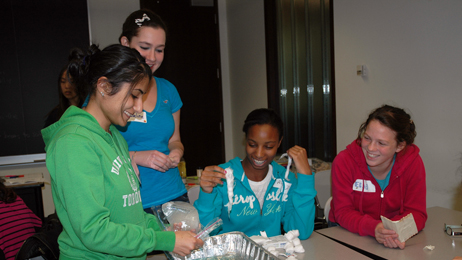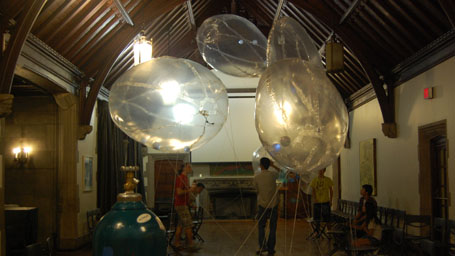
Rezwana Sharmin (EngSci 1T0 + PEY) has wanted to inspire young girls to pursue engineering since her very first year at U of T.
Sharmin got her first taste of it while working as an instructor’s assistant for the Faculty’s outreach program, Girls Science & Engineering Saturday. “The instructor was such an inspiration, to the girls, and to me. She made me and everyone else think, ‘Yes, I could do this.’”
Fast-forward to this year, and Sharmin has the opportunity to tell girls that, yes, they can do this too.
On October 1, engineering schools across Ontario hosted the event, which is organized in partnership with the Ontario Society of Professional Engineers (OSPE). Go ENG Girl gives girls in grades seven to ten the chance to explore opportunities in engineering through a number of hands-on activities. Go ENG Girl also provides the students and their parents with the information they need to choose the right high school courses in order to study engineering at the post-secondary level.

U of T’s event is organized by the Engineering Student Outreach Office, which welcomed more than 130 participants.
Throughout the day, Sharmin, her fellow instructors, and volunteers led the girls through engineering-oriented activities including a design challenge that showed participants how science and engineering can save polar bears.
“It is crucial for U of T Engineering to host events such as Go ENG Girl,” said Dean Cristina Amon, “It is a tremendous opportunity to demonstrate that engineering is about more than technology or machinery—it is a caring profession that improves people’s everyday lives and solves global challenges.”
This year’s event was Sharmin’s second time as a Go ENG Girl instructor. “The girls are so brilliant,” she said, “They come up with these creative ideas that just blow your mind.”
She hopes that events like Go ENG Girl will inspire more girls to become the engineers of tomorrow. “Girls should choose what they want to do, but sometimes they don’t consider engineering,” said Sharmin. “The ratio of girls to boys in my program is a little low, but each and every girl is amazing. So I want these girls to know that engineering is an option.”

At the University of Toronto’s Hart House, seven large blimps hover above students’ heads. The blimps – tied to the ground by delicate strings and filled with lights – was a spectacle to behold at Nuit Blanche on October 1.
Nuit Blanche is an annual night-long celebration of contemporary art with displays, exhibitions and performances occurring across Toronto, including on U of T’s St. George campus.
Led by U of T Engineering student Geoff Frost (EngSci 0T9 + PEY, IBBME MASc candidate), the Solar Blimp Design Team is unveiling an art installation that gave art goers a glimpse of their much larger and ongoing solar-powered blimp design project.
“The project itself is to build a moving ‘airship’ that is powered and navigated using solar energy,” said Frost, who hopes to complete it by the end of the year. “The art installation, on the other hand, is an immobile art piece. But we wanted to do it to involve students, the community, and to expose ourselves – us engineering students – to the world of art.”
The team of about 20 consists of mostly U of T Engineering students, but also includes students from political science at U of T, and architecture from the University of Waterloo.
Members of the Solar Blimp Design Team weren’t the only ones representing U of T Engineering, however. Several blocks away, in the lobby of the Keenan Research Centre, was the “Elephant in the Room.”
Students from the University of Toronto Robotics Association (UTRA) worked with architects to create a three-dimensional celestial elephant. The stars that made up the shape of the elephant were created with approximately 1,000 optical fibres, which were illuminated by proprietary light boxes. The sheer size of the installation meant it was a twinkling success amongst the Nuit Blanche crowd.
Not-for-profit organization, Socially and Environmentally Responsible Aggregates (SERA), has named Professor Brenda McCabe, Chair of the Department of Civil Engineering, as its Chair of its newly formed expert technical panel.
Professor McCabe leads a group of experts – representing municipal, industry, community and environmental interests – who will produce a final voluntary standard that establishes credible, practical and measurable requirements for socially and environmentally responsible aggregate extraction in Ontario.
“I am very pleased to be chairing this important group for SERA,” said Professor McCabe, who brings a wealth of construction sector knowledge to the panel. “Voluntary certification initiatives such as SERA have proven an effective model for encouraging and rewarding the adoption of best social and environmental practices amongst other resource sectors.”
Click here to learn more about SERA’s new advisory panel.
On the morning of September 27, faculty members and industry came together to discuss nanotechnology.
Supported by NSERC and co-hosted by MITACS, the NSERC Nanotechnology Connector Breakfast was a chance for U of T researchers – particularly engineering researchers – to connect with industry, and explore collaborative funding opportunities.
“It is a pleasure to be part of one of the first NSERC Connector events at U of T,” said Professor Peter Lewis, U of T’s Associate Vice-President (Research), who opened the event. “Nanotechnology is a research priority at U of T, and especially in the Faculty of Applied Science & Engineering. The University strongly encourages new partnerships with industry, as it leverages new and successful ventures.”
Professor Stewart Aitchison (ECE), Vice-Dean, Research, and Director, Emerging Communications Technology Institute (ECTI), then gave an overview of the cutting-edge micro- and nano-fabrication facilities available at U of T’s ECTI – a workspace that makes nanotechnology-related research possible.
The guests – more than 20 industry representatives and 25 faculty members – were treated to presentations on Surface Interface Ontario’s facilities and services, NSERC’s Engage program, and its Collaborative Research and Development program, Mitacs’ industrial partnership programs, and more.
Professors Nazir Kherani (ECE, MSE), Joyce Poon (ECE) and Paul Santerre (Director, IBBME) touched on the impact nanotechnology has on their research areas – from energy, to information and communications technologies, to biology and biomedicine.
“I’m very pleased with the enthusiasm we saw for this event – from my colleagues in Engineering and from our industry contacts. They see the value of increased collaboration, and this event was designed to help make those connections,” said Professor Aitchison, “Sometimes there are specific technical problems that a university researcher can shed new light on, and sometimes there are commercialization prospects to explore. This was an opportunity to explore the beginnings of potentially fruitful collaborations.”

The Faculty of Applied Science & Engineering mourns the passing of Professor Emeritus Gordon R. Slemon (ECE).
Professor Slemon, who died on September 26 at age 87, served as Chair of the Department of Electrical Engineering from 1966 to 1976, and Dean of U of T Engineering from 1979 to 1986.
He was highly regarded as the international authority on the analysis, design and development of electric machines and controlled drive systems. Throughout his career, Professor Slemon garnered countless honours, including being named Officer of the Order of Canada for his dedication to engineering education and research.
In 1990, he was awarded the IEEE Nikola Tesla Award, which is given to those who have made outstanding contributions to the generation and utilization of power. Professor Slemon, an elected Fellow of the Canadian Academy of Engineering, authored more than 175 technical reports and publications, and served as an engineering consultant to more than 70 Canadian organizations. In 2011, he was recognized with the Engineering Institute of Canada’s highest honour, the Sir John Kennedy Medal.
“Professor Emeritus Gordon R. Slemon will be remembered as an extraordinary leader in engineering, who has been a tremendous influence on the profession and U of T Engineering,” said Dean Cristina Amon, “On behalf of the Faculty, I send my deepest condolences to his family.”
Researchers at the University of Victoria and U of T Engineering Professor David Sinton (MIE) will design a new fibre-optic system to monitor carbon dioxide (CO2) at underground storage sites.
Carbon Management Canada will provide the team with a $983,578 grant to research ways CO2 can be safely injected into storage formations, which has the potential to reduce harmful emissions from power generating stations that burn coal.
The three-year project, headed by the University of Victoria, will begin in the lab and then shift outdoors for field tests.
In designing a new system to monitor CO2 concentrations, the researchers will make use of patented fibre-optic technology, along with patented techniques to measure CO2 fluxes.
Carbon Management Canada is a Network of Centres of Excellence supported by federal and provincial governments as well as industry. CMC is a community of over 150 university researchers, and industry and government practitioners with the vision, the commitment, and the enthusiasm needed to take the upstream fossil energy industry to zero carbon emissions.
